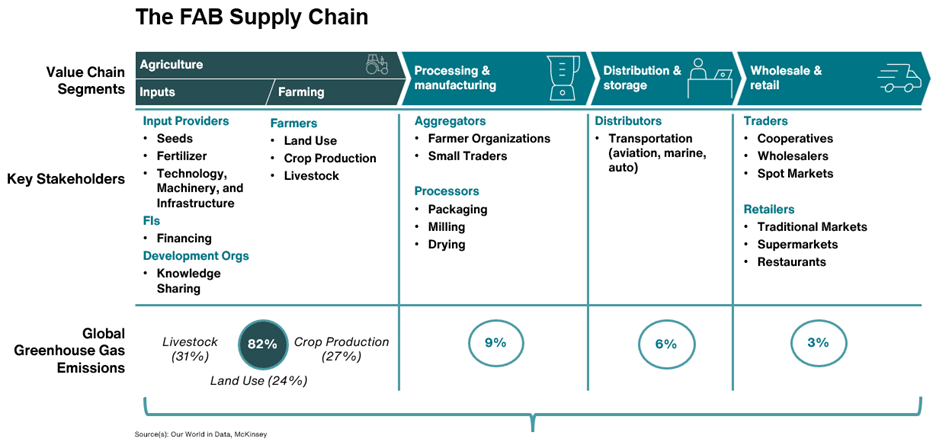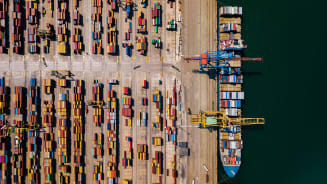Improving Agricultural Practices to Address Climate Risks

Good agricultural practices reduce emissions, expand carbon sequestration and benefit the supply chain from the very first mile — all key components of achieving future climate goals.
Key Takeaways
-
The FAB industry produces more than one-third of global greenhouse gas emissions, but sustainable practices are emerging.
-
Supporting farmers who are using regenerative agricultural practices benefits the entire supply chain and reduces damaging environmental impacts.
-
De-risking projects and using climate analytics will help secure investment, expand insurance capacity and mitigate physical climate risk.
Better Informed
The food, agribusiness and beverage (FAB) industry is a significant contributor to climate change. It produces more than one-third of global greenhouse gas emissions and accounts for 70 percent of our global use of freshwater. With the worldwide population anticipated to reach almost 10 billion by 2050, finding more sustainable and equitable ways to feed a growing population requires urgent action by an industry that already faces increasing pressure to innovate its processes and products.
Across the world, solutions to address climate stress linked to food systems are in high demand, and are driven by a mix of science, innovation and digital acceleration. Regenerative agriculture is increasingly seen as a critical climate solution. The Food and Agriculture Organization of the United Nations calls it “an inclusive agroecosystems approach for conserving land and soil, biodiversity and improving ecosystem services within farming systems.”
Scaling up regenerative practices can support habitat restoration, conservation, increase food security and farmers’ incomes and reduce supply chain risks such as raw material price volatility for producers.
The FAB value chain is highly consolidated, except at the base or the “first mile,” where farmers, growers and fishers are typically small-scale, individual or family businesses, with little connectivity to the end market they serve. De-risking the first mile of the supply chain will help scale food production sustainably to feed a growing global population, while limiting supply chains’ impact on nature (also referred to as “externalities”).

“Climate is a material and evolving enterprise risk, and a strategic priority for the C-suite. The challenges in transitioning, de-risking and scaling production are clear pain points for our clients. They make up the focus of our collaboration with partners to ensure the food system becomes more sustainable.”
– Ciara Jackson, Global Food, Agribusiness and Beverage Leader
Better Advised
Regenerative Agriculture Addresses Several Climate Challenges
Regenerative agriculture and the conversation around how to store more water in the soil is discussed frequently. Correct implementation of regenerative nature practices leads to many co-benefits:
- While fresh water is used by many industries, agriculture uses up to 70 percent of available fresh water globally. By transitioning to more regenerative agriculture practices, this demand will be cut in half.
- Soil can absorb water from rainfall more efficiently, reducing the risk of flooding and keeping moisture in the soil when drought hits. Healthy soils also release water slowly, which reduces the need to irrigate.
- These methods also have advantages when it comes to carbon sequestration. As soil health is rebuilt, it supports more biodiversity, making it possible to store carbon as well as micro and nano-nutrients. Conversely, unhealthy soil leads to water runoff, which can carry away not only the fertile topsoil of crops, but also pollutants, such as man-made pesticides and fertilizers. This may then contaminate the fresh water supply.
- In the event of extreme weather events, such as flash floods or droughts, water that has been re-absorbed and stored in the soil creates a healthy ecosystem. The combination of improved chemistry and soil structure creates a stabilizing effect. The roots of the plants can grow deeper, thanks to a breathing, structured soil that protects the plants by anchoring them more strongly in the earth.
Transitioning to regenerative agricultural practices takes time, and there is inherent volatility in the process. There must be a strong incentive for farmers to make the shift. Farmers typically incur the risk of transitioning through yield reduction as they initially reduce fertilizer inputs.
“De-risking is essential,” remarked Andrew Mude, an economist with the African Development Bank Group, at an Aon-hosted event during Climate Week NYC in September 2023. “As Africa rightfully increases the share of climate mitigating and adaptation financing it receives, directing some of these resources to improve the integration of risk management in Africa’s agri-food system will accelerate the transition to a resilient and sustainable agriculture."
Implementing regenerative practices at scale would immediately reduce systemic physical climate risk. Reduced volatility in supply chains benefits producers and consumers. De-risking regenerative agricultural practices will encourage farmers to make this transition, safe in the knowledge that they are protected financially.
Better Decisions
$108B
Between 2008 and 2018, the impacts of natural disasters cost the agricultural sectors of developing countries over $108 billion in damaged or lost crop and livestock production.
Source: United Nations, March 2021
Three Ways to Match Data to Risk Capital for Sustainable Agriculture
In order to de-risk these new farming practices, data is needed to develop innovative risk financing solutions and promote financial inclusion for small-scale farmers.
-
Crop Insurance
At the farmer level, crop insurance is the seed of resilience for small farmers who are exposed to the worst impacts of climate change. Supporting them through their journey toward healthier, climate-resilient soil and crops will yield both improvement and financial resilience. Producers will benefit from lower raw material volatility. They will also have access to crop data on a real-time basis, allowing for transparency, risk management and reporting. There is significant potential for all participants across the entire value chain. Thanks to emerging technologies, it is now possible to monitor crops and soil health at a much more granular level to better understand effective care and monitor progress toward genetic potential.
-
Transparency in Data
In addition to lower raw material price volatility, producers will also benefit from greater transparency in data to monitor crop data in real-time. This allows for better risk management and easier regulatory reporting. The data gathered will help assess physical risk, and lower transition risk and reputational risk at a time when “greenwashing” has become a concern among investors and a reputation risk for companies.
-
Improvement in Risk Assessment
For insurers, emerging data, analytics and technology — such as hyper-granular satellite data capture and AI — will unlock innovation and improve risk assessment. This means regions that previously had limited transparency, which made risk, yield and loss assessment challenging, can now be closely monitored and protected by specialty insurance.
“Insurers can also support farmers beyond access to insurance by providing advanced warnings in case of extreme weather events,” says Stephanie Betts, global head of alliances, coalitions and reporting in Aon’s Climate team. “And they can educate farmers on the steps to transition to regenerative practices, which will benefit the whole ecosystem by lowering systemic risk in our food systems.”
$24B
Profits for the world’s largest livestock producers could fall by almost $24 billion by 2030 as a direct impact of climate change.
Source: FAIRR
Working Together for a Sustainable Future
In a globalized and hyper-connected world, supporting and protecting farmers through the life cycle of their crops creates returns that benefit the entire FAB ecosystem. As farmers adopt more sustainable practices, co-benefits will ripple through the value chain, support local GDP growth, and mitigate crop damage and drought, while helping the world progress toward a net zero future.
$1.5T
The top 25 companies in the FAB sector generated $1.5 trillion in revenue in the past year, while profits for the sector increased to more than $155 billion.
Source: Forbes Global 2000: The World’s Largest Food Companies In 2022
While there’s impressive innovation around climate tech and carbon sequestration, carbon capture starts with soil. If we don’t make these changes to our agricultural systems, the game is up. The energy transition will be hampered by water scarcity.
Helping people make the right climate decisions involves de-risking these practices through improved data and technology, and enabling capital to flow where it needs to, thus addressing the protection gap.
General Disclaimer
The information contained herein and the statements expressed are of a general nature and are not intended to address the circumstances of any particular individual or entity. Although we endeavor to provide accurate and timely information and use sources we consider reliable, there can be no guarantee that such information is accurate as of the date it is received or that it will continue to be accurate in the future. No one should act on such information without appropriate professional advice after a thorough examination of the particular situation.
Terms of Use
The contents herein may not be reproduced, reused, reprinted or redistributed without the expressed written consent of Aon, unless otherwise authorized by Aon. To use information contained herein, please write to our team.
Aon's Better Being Podcast
Our Better Being podcast series, hosted by Aon Chief Wellbeing Officer Rachel Fellowes, explores wellbeing strategies and resilience. This season we cover human sustainability, kindness in the workplace, how to measure wellbeing, managing grief and more.
Aon Insights Series UK
Expert Views on Today's Risk Capital and Human Capital Issues
Construction and Infrastructure
The construction industry is under pressure from interconnected risks and notable macroeconomic developments. Learn how your organization can benefit from construction insurance and risk management.
Cyber Labs
Stay in the loop on today's most pressing cyber security matters.
Cyber Resilience
Our Cyber Resilience collection gives you access to Aon’s latest insights on the evolving landscape of cyber threats and risk mitigation measures. Reach out to our experts to discuss how to make the right decisions to strengthen your organization’s cyber resilience.
Employee Wellbeing
Our Employee Wellbeing collection gives you access to the latest insights from Aon's human capital team. You can also reach out to the team at any time for assistance with your employee wellbeing needs.
Environmental, Social and Governance Insights
Explore Aon's latest environmental social and governance (ESG) insights.
Q4 2023 Global Insurance Market Insights
Our Global Insurance Market Insights highlight insurance market trends across pricing, capacity, underwriting, limits, deductibles and coverages.
Regional Results
How do the top risks on business leaders’ minds differ by region and how can these risks be mitigated? Explore the regional results to learn more.
Human Capital Analytics
Our Human Capital Analytics collection gives you access to the latest insights from Aon's human capital team. Contact us to learn how Aon’s analytics capabilities helps organizations make better workforce decisions.
Insights for HR
Explore our hand-picked insights for human resources professionals.
Workforce
Our Workforce Collection provides access to the latest insights from Aon’s Human Capital team on topics ranging from health and benefits, retirement and talent practices. You can reach out to our team at any time to learn how we can help address emerging workforce challenges.
Mergers and Acquisitions
Our Mergers and Acquisitions (M&A) collection gives you access to the latest insights from Aon's thought leaders to help dealmakers make better decisions. Explore our latest insights and reach out to the team at any time for assistance with transaction challenges and opportunities.
Navigating Volatility
How do businesses navigate their way through new forms of volatility and make decisions that protect and grow their organizations?
Parametric Insurance
Our Parametric Insurance Collection provides ways your organization can benefit from this simple, straightforward and fast-paying risk transfer solution. Reach out to learn how we can help you make better decisions to manage your catastrophe exposures and near-term volatility.
Pay Transparency and Equity
Our Pay Transparency and Equity collection gives you access to the latest insights from Aon's human capital team on topics ranging from pay equity to diversity, equity and inclusion. Contact us to learn how we can help your organization address these issues.
Property Risk Management
Forecasters are predicting an extremely active 2024 Atlantic hurricane season. Take measures to build resilience to mitigate risk for hurricane-prone properties.
Technology
Our Technology Collection provides access to the latest insights from Aon's thought leaders on navigating the evolving risks and opportunities of technology. Reach out to the team to learn how we can help you use technology to make better decisions for the future.
Top 10 Global Risks
Trade, technology, weather and workforce stability are the central forces in today’s risk landscape.
Trade
Our Trade Collection gives you access to the latest insights from Aon's thought leaders on navigating the evolving risks and opportunities for international business. Reach out to our team to understand how to make better decisions around macro trends and why they matter to businesses.
Weather
With a changing climate, organizations in all sectors will need to protect their people and physical assets, reduce their carbon footprint, and invest in new solutions to thrive. Our Weather Collection provides you with critical insights to be prepared.
Workforce Resilience
Our Workforce Resilience collection gives you access to the latest insights from Aon's Human Capital team. You can reach out to the team at any time for questions about how we can assess gaps and help build a more resilience workforce.
More Like This
-

Article 8 mins
Responding to Cyber Attacks: How Directors and Officers and Cyber Policies Differ
Cyber incidents continue to grow in frequency and severity, especially as new technology emerges. While D&O and cyber liability policies offer distinct coverage differences, terms need to be carefully structured to avoid potential gaps.
-

Alert 3 mins
Better Decisions Brief: Responding to the CrowdStrike IT Outage
While the impact of today’s CrowdStrike outage is yet to be fully understood, it serves as an opportunity for C-suite and other business decision-makers to think through technology dependencies and the steps necessary to respond to this outage – as well as to mitigate related risks in future.
-

Article 8 mins
Insurance and the Metaverse: Safeguarding Virtual Assets
Insurers are venturing into the thriving digital landscape of the Metaverse, covering virtual assets, safeguarding intellectual property, and protecting the wellbeing of users and avatars. With this evolution, comes new challenges and the unique opportunity to shape the future of insurance.





















































































































